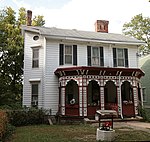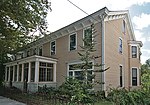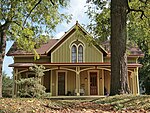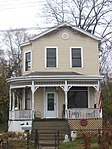Spencer Township Hall
City and town halls in OhioCity and town halls on the National Register of Historic Places in OhioGovernment buildings completed in 1860Greek Revival architecture in OhioNational Register of Historic Places in Cincinnati ... and 1 more
Odd Fellows buildings in Ohio

The Spencer Township Hall is a historic former government building in the Columbia-Tusculum neighborhood of Cincinnati, Ohio, United States. One of Cincinnati's oldest extant public buildings, it has been designated a historic site because of its architecture.
Excerpt from the Wikipedia article Spencer Township Hall (License: CC BY-SA 3.0, Authors, Images).Spencer Township Hall
Eastern Avenue, Cincinnati Columbia-Tusculum
Geographical coordinates (GPS) Address Nearby Places Show on map
Geographical coordinates (GPS)
| Latitude | Longitude |
|---|---|
| N 39.110833333333 ° | E -84.435 ° |
Address
Eastern Avenue & Donham Avenue
Eastern Avenue
45226 Cincinnati, Columbia-Tusculum
Ohio, United States
Open on Google Maps











